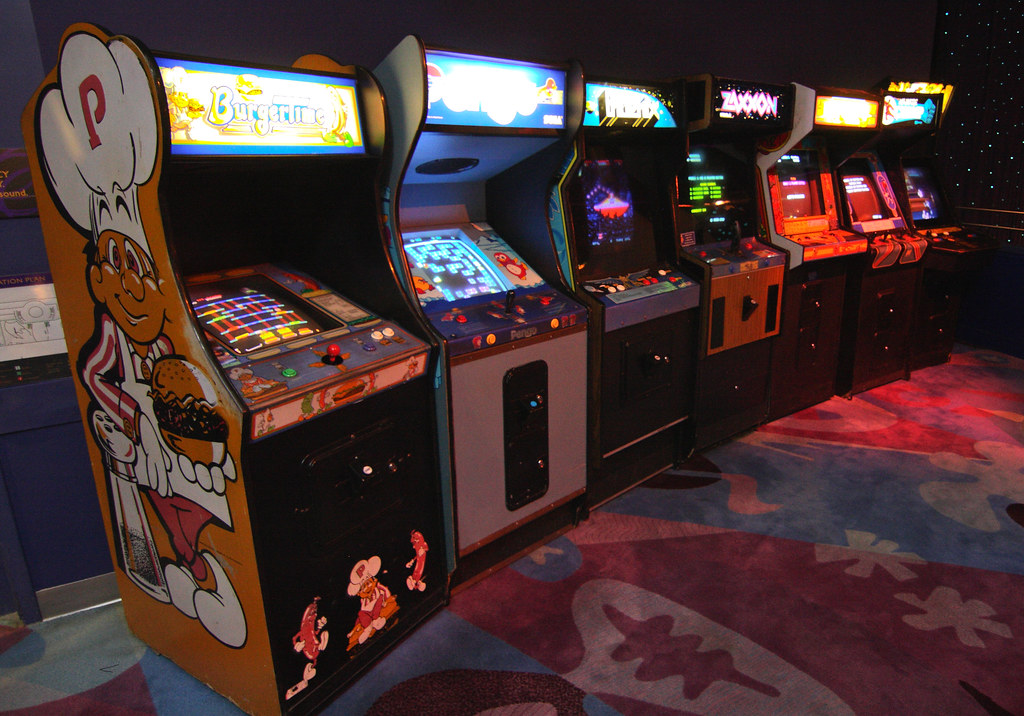Arcade games have shaped the landscape of interactive entertainment, captivating players since the 1970s with their vibrant graphics and addictive gameplay. As we delve into the evolution of these beloved games, we uncover a treasure trove of innovations that have not only transformed arcade cabinets but also influenced the entire gaming industry. From the initial pixelated adventures to today’s sophisticated experiences, the journey of arcade games is rich with milestones that deserve recognition.
Over the decades, various genres have emerged, each with its unique flair, from platformers that challenge players’ dexterity to intense shooters that bring excitement to the forefront. Iconic titles such as Pac-Man and Street Fighter have left indelible marks on gaming culture, while their mechanics and design principles continue to resonate in modern gaming. This exploration reveals not just the history but also the lasting impact of arcade games on the gaming community, as we trace the timeline of their influence.
History of Arcade Games
The evolution of arcade games traces a fascinating journey from simple pixelated screens to immersive gaming experiences. Beginning in the 1970s, arcade games have significantly influenced both gaming technology and culture, shaping the way players interact with digital entertainment. This historical overview highlights key milestones in arcade game development, showcasing notable titles and technological advancements that have left a lasting imprint on the industry.
Evolution from the 1970s to Present Day
The 1970s marked the inception of arcade gaming, with the release of iconic games that laid the groundwork for the industry. The following timeline highlights major releases, innovations, and their cultural impact:
- 1971: Computer Space – Considered the first commercially available arcade video game, it set the stage for future developments.
- 1972: Pong – Atari’s Pong became a cultural phenomenon, popularizing the concept of arcade gaming with its simple yet addictive gameplay.
- 1978: Space Invaders – This game revolutionized arcade gaming by introducing a scoring system and levels, igniting the “golden age” of arcade games.
- 1980: Pac-Man – With its iconic character and maze-chase gameplay, Pac-Man became a global icon, transcending gaming into popular culture.
- 1985: Super Mario Bros. – Though primarily known as a home console game, its arcade variant contributed to the console’s success and defined platform gaming.
- 1996: Street Fighter II – This title redefined fighting games, introducing competitive multiplayer elements that became staples in arcades.
- 2000s: Dance Dance Revolution – Blending physical activity with gaming, this rhythm game diverged from traditional formats and appealed to a broader audience.
- 2010s: Mobile Arcade Revival – The resurgence of arcade-style games on mobile platforms showcased the genre’s adaptability and enduring appeal.
The impact of these milestones has been profound, shaping gaming culture, inspiring countless sequels, and sparking a new generation of developers.
Key Technologies in Arcade Game Development
A significant aspect of the evolution of arcade games has been the technological advancements that have transformed gameplay experiences. Key technologies include:
- Microprocessor Technology: Enabled more complex games with better graphics and processing capabilities.
- Vector Graphics: Introduced in games like Asteroids, vector graphics provided sharper visuals and smoother motion.
- 3D Graphics: The transition to 3D graphics in the 1990s opened new avenues for game design, as seen in titles like Virtual Fighter.
- Network Connectivity: Allowed for multiplayer experiences and competitive gaming across arcade machines, enhancing social interaction.
Key technologies have not only improved the quality of games but have also expanded the possibilities for game design and interaction, leading to a more immersive arcade experience.
“The evolution of arcade games reflects the technological advancements of their times, providing players with ever-evolving experiences that drive cultural trends.”
Popular Genres of Arcade Games

Arcade games have evolved dramatically over the decades, leading to the emergence of various genres that cater to a wide range of gaming preferences. Each genre possesses unique characteristics that contribute to its appeal within the arcade gaming community. Understanding these popular genres not only highlights the diversity of arcade gaming but also showcases the iconic titles that have shaped the industry.
Platformers
Platformers are a quintessential genre in arcade gaming, characterized by jumping between platforms and navigating through obstacles. The appeal lies in their straightforward mechanics and engaging level designs, which often encourage skillful play and perseverance. These games are typically fast-paced, requiring players to react quickly to challenges.
Some iconic examples of platformers include:
- Donkey Kong (1981) – This classic game introduced players to Mario, who must rescue a damsel in distress from the clutches of the titular ape. Its innovative design laid the groundwork for future platformers.
- Super Mario Bros. (1985) – Although primarily known for its console success, its arcade adaptations were pivotal in popularizing platforming gameplay with vibrant worlds and power-ups.
- Bubble Bobble (1986) – Featuring cute characters and cooperative gameplay, it enhanced the multiplayer experience in arcades, making it a beloved title among players.
Shooters, Arcade games
Shooters, another dominant genre in the arcade scene, involve players controlling a character or vehicle while aiming to eliminate enemies. The adrenaline-pumping action and competitive score-chasing make shooters particularly appealing. They often feature fast reflexes, quick decision-making, and a variety of weaponry.
Notable shooter games include:
- Space Invaders (1978) – One of the earliest shooting games, it popularized the genre with its strategic gameplay, where players defend against waves of aliens.
- Galaga (1981) – Building upon the foundation of Space Invaders, this title introduced advanced mechanics like the ability to rescue captured ships, enhancing gameplay depth.
- Raiden (1990) – A vertical scrolling shooter known for its intense, fast-paced action and cooperative gameplay, it remains a staple in arcade culture.
Fighting Games
Fighting games emphasize one-on-one combat between characters, often featuring unique fighting styles, special moves, and combo systems. The genre’s competitive nature and the ability to master different characters make it a favorite among arcade enthusiasts.
Examples include:
- Street Fighter II (1991) – Revolutionizing the fighting game genre, it introduced a diverse cast of characters and strategic depth that encouraged competitive play.
- Mortal Kombat (1992) – Known for its graphic violence and finishing moves, it pushed boundaries and created a cultural phenomenon that persists today.
- Tekken (1994) – With its 3D graphics and intricate character development, it became a staple in both arcades and competitive tournaments.
Platformers, shooters, and fighting games each offer distinct experiences that resonate with players, ensuring their lasting presence in the arcade gaming landscape.
The Influence of Arcade Games on Modern Gaming

Arcade games, with their vibrant graphics and engaging mechanics, have significantly shaped the landscape of modern gaming. The influence of these early gaming experiences is evident in various aspects of contemporary game design, from gameplay mechanics to user engagement strategies. This legacy continues to resonate with players, blending nostalgia with innovative elements that define today’s gaming world.
One of the most notable impacts of arcade games on modern gaming is seen in the design and mechanics of games. The simplistic yet addictive gameplay of classic arcade titles paved the way for the development of various genres in today’s gaming ecosystem. The emphasis on quick, enjoyable gameplay loops has inspired developers to create experiences that can be consumed in short bursts, aligning perfectly with the fast-paced lifestyle of many players today. Key design elements influenced by arcade games include:
- High Score Systems: Arcade games often revolved around achieving the highest possible score, a concept that has been seamlessly integrated into modern video games. Today, many games feature leaderboards, score tracking, and achievements that encourage competition and replayability.
- Multiplayer Mechanics: The social aspect of arcade gaming, where players would compete side by side, has evolved into online multiplayer experiences. Games now often include co-op modes, competitive play, and community challenges that echo the camaraderie and rivalry found in arcades.
- Power-Ups and Bonuses: The use of power-ups to enhance gameplay is a staple of arcade games, and this mechanic has persisted in contemporary titles. Players now encounter various types of enhancements that add a layer of strategy and excitement, reminiscent of the arcade era.
Revival of Arcade-Style Games
In recent years, there has been a notable revival of arcade-style games, both in mobile and console formats. This resurgence highlights the timeless appeal of arcade gaming, attracting both nostalgic players and a new generation of gamers. The simplicity and immediacy of these games make them accessible, allowing players to dive into the action without extensive learning curves.
This revival can be attributed to several factors, including:
- Mobile Gaming Growth: The rise of smartphones has enabled the distribution of arcade-inspired games through app stores. Titles like “Crossy Road” and “Super Mario Run” embody the arcade spirit, appealing to players looking for quick entertainment.
- Indie Game Development: The indie game scene has embraced arcade aesthetics, producing titles that capture the essence of classic gameplay while incorporating modern technology. Games such as “Cuphead” and “Katana Zero” showcase vibrant visuals and challenging mechanics reminiscent of old-school arcade experiences.
- Community Engagement: Modern arcade-style games often utilize social media and online platforms to foster community engagement, allowing players to share scores, strategies, and experiences. This community-centric approach mirrors the social environment of traditional arcades.
The reception of these arcade-style games has been overwhelmingly positive, with players appreciating the blend of nostalgia and modern gameplay innovations. This continual evolution highlights the enduring influence of arcade games on the gaming industry, ensuring that their legacy will be felt for generations to come.
Outcome Summary
In conclusion, the legacy of arcade games stands as a testament to the creativity and innovation that defines the gaming world. As we reflect on their evolution and the genres they birthed, it becomes clear that these games have not only entertained millions but also paved the way for contemporary game design. The revival of arcade-style games in new formats serves as a reminder of the nostalgia and excitement they bring, ensuring that the spirit of arcade gaming lives on in the hearts of both old and new players alike.

